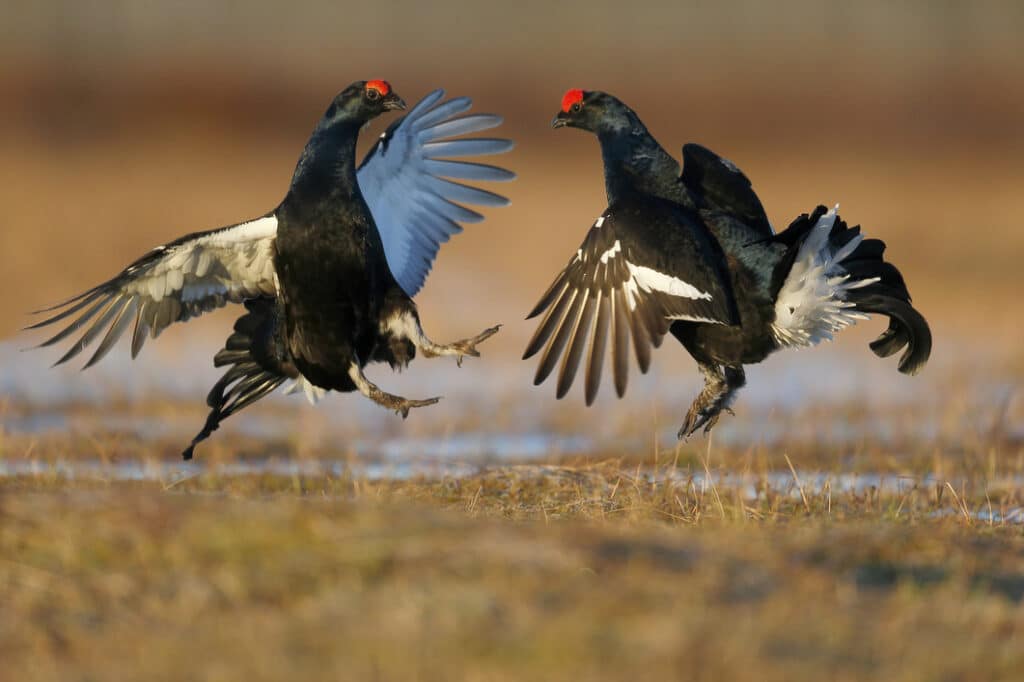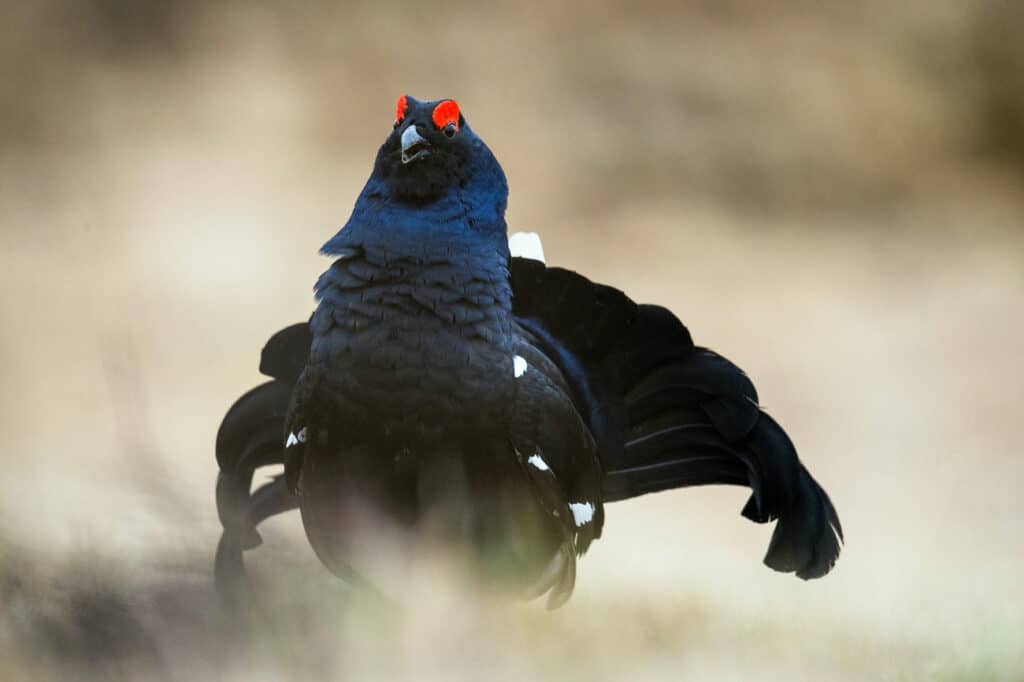Facts about Black Grouse
Scientific name: Tetrao tetrix
Bird Family: Grouse
UK conservation status: Red
At a glance
- UK resident, long-term severe breeding population decline.
- Males 'lek', competing for females in complex and communal courtship displays.
- Despite Red-listing in 2021, Black Grouse can still be legally shot in England, Scotland and Wales.

There are four species of grouse in the UK: the Red Grouse; its close cousin the Red-listed Ptarmigan; the Red-listed and nearly-extirpated Capercaillie (the largest member of the grouse family); and the Black Grouse.
The Black Grouse is a spectacular bird found across the Palaearctic in a fine-scale mosaic of habitats where relatively small areas of woodland, moorland and grassland/meadow meet and overwintering in flocks in dense forests. Like many other species, the females are cryptically-patterned to hide from predators when nesting but males are inky-black with red wattles and a flamboyant lyre-shaped tail used to display at what is known as a lek.
One of just thee UK species to perform these communal displays (the others are the Capercaille and a scarce shorebird, the Ruff), lekking Black Grouse are a wonder to watch. Birds assemble at dawn in open areas that provide them with good acoustics and visibility, and males face up to each other while making continual bubbling sounds, flutter-jumping and fanning out their white undertail feathers and lyre-shaped outer-tail feathers.

Sadly, like so much of our more specialised wildlife, Black Grouse and their leks are vanishing from the moorlands and upland edge habitats of Britain. Populations have crashed in the last half-century, and the species has been described as “a potent symbol of the way in which land-use changes in the uplands have affected biodiversity”.
Long-term severe breeding population decline has led to the Black Grouse being Red-listed, making it a species of the highest conservation concern, listed as a ‘Priority Species’ of the UK Government’s Biodiversity Action Plan (BAP), and one of the key woodland species identified for action under the Scottish Forestry Strategy 2006.
Commercial forestry plantations, dark row upon dark row of a single species of conifer once pushed as investment vehicles until their negative impact on unique upland landscapes was understood, appear to be a major factor in the decline of Black Grouse. A 2015 report concluded that “avoiding uniform stands of intermediate (20 years) age may provide Black Grouse with access to sufficient areas of open habitats within woodlands, and may be important to their future conservation”, describing precisely NOT what forestry plantations provide. Collisions with fences erected to protect those plantations from browsing deer have also been found to be a significant cause of adult mortality.
Enormous changes in agriculture (in particular) have also substantially altered the landscape mosaic which Black Grouse require. Farming subsidies have led to the widespread draining and ploughing of rough grazing land. Fields are regularly fertilised reducing the variety of grass species. Rye grass, which grazing sheep favour, has pushed out heather and other dwarf shrubs. Heavy grazing by both sheep and deer levels the tall vegetation grouse require for shelter (and may lead to higher predation), and can lead to the loss of shrub dominated vegetation reducing food availability.
The loss of wet flushes (areas where water from underground flows out onto the surface to create an area of saturated ground) has also led to far fewer of the invertebrates which all young grouse chicks depend on, a factor also implicated in the precipitous decline of the Curlew. Climate change which is drying out moorlands even further and changing when food is available, will also become an increasing threat to what remains of the UK’s Black Grouse population.

Remarkably, though, despite Red-listing, BAP-listing, the natural wonder of the lek, being ‘a potent symbol’ etc etc, Black Grouse can still be legally shot in England, Scotland and Wales between August and December.
There is a voluntary moratorium on shooting Black Grouse in some areas, and shooting lobby group GWCT, supposedly one of the more restrained voices in shooting our native wildlife, has published what they grandiosely call “Shooting: A sportsman’s code” which suggests that “sustainable shooting is possible only where productivity is high”, and asks that “all guns can identify greyhens [female Black grouse] and don’t confuse them with red grouse”. This rather ignores the fact that Black Grouse shouldn’t be shot at all, and perhaps comes off the back of a 2011 report into shooting Black Grouse that began with the chilling observation that “In northern England, 95% of Black Grouse leks occur on the fringes of managed grouse moors. Recognising the threatened conservation status of black grouse in northern England, most grouse moors have refrained from deliberate shooting for more than a decade. Despite this, black grouse are unintentionally shot in mistake for Red Grouse” (which mirrors findings that Red-listed Grey Partridges are ‘accidentally’ shot by shooters unable to identify them from the non-native and deliberately-released Red-legged Partridge).
While many shooting estates do limit the shooting of Black Grouse, this hasn’t stopped calls for it to continue – and even lead to suggestions from one renowned ‘conservationist’ shooter that allowing more shooting of Black Grouse would actually benefit them as estates would see their commercial benefit and protect habitat for them. To its credit the RSPB called the idea ‘simplistic and specious’, saying that the steepest of declines in Black Grouse numbers occurred when the species was still being shot anyway.
